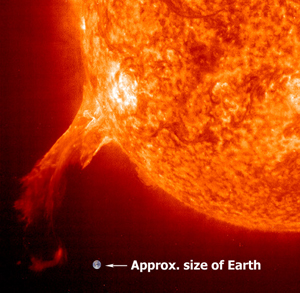Celestis’ Sunjammer solar sail is a NASA-funded starship that will travel many millions of miles toward the Sun, demonstrating – for the first time – a solar sail’s ability to fly and to navigate, as well as to provide early warning against the dangers of solar storms heading Earth’s way. This will also be a memorial spaceflight mission, carrying the cremated remains of people on this history-making journey.
But what are these solar storms, and what dangers do they pose?

The solar storms are technically called “coronal mass ejections” (CMEs):
- The outer layer of the Sun is referred to as the Sun’s “corona.”
- From time to time, the corona will erupt, spewing (ejecting) huge amounts of charged particles (part of the mass of the Sun) into space.
- The danger is, if one of these CME’s impacts Earth, the charged particles — interacting with Earth’s magnetic field — can play havoc with electricity grids, radio communications, computer systems, etc., which could result in widespread chaos lasting for years at a time.
In the modern era we have experienced relatively minor CMEs. But major CMEs have impacted the Earth in the past — well before the development of our modern, high tech society — and undoubtedly will impact us again in the future. For example, on March 13, 1989 a moderate CME caused an electric blackout in the Canadian province of Quebec that lasted approximately nine hours. But on September 1, 1859 a much more powerful CME impacted Earth. While we didn’t have computers, satellites and massive electricity grids at that time, we did have the telegraph: The 1859 CME’s impact on the world’s telegraph systems provides a cautionary tale for us today. During this CME, telegraph machines across North America, Europe, Australia and parts of Asia threw off sparks, shocking telegraph operators, setting small fires and effectively bringing down telegraph systems for two days. The 1859 CME is known as the “Carrington Event,” named after British amateur astronomer Richard Carrington who observed large sunspots and a massive solar flare at the time of the 1859 CME, and drew a connection to the effects observed on Earth.
Carrington Events are estimated to occur approximately once every 150 years: It’s not a question of “if,” but of “when” the next one will head our way. When a Carrington Event eventually impacts our increasingly electronic, interconnected, wired society, the results could be catastrophic. In a 2013 report Lloyd’s of London estimates that a Carrington Event could leave 20-40 million Americans without electricity for up to two years! The most vulnerable areas for the United States, Lloyd’s reports, include: the New York City-Washington, DC corridor; the Midwest and the Gulf Coast. Imagine the chaos that would occur if a major urban area, such as New York City, lost electric power for two years — or even for two weeks! No electricity would mean no lighting, no power to pump water and run sewage systems, no refrigeration, no subways, no elevators, no air conditioning….
However, with enough warning of a CME, managers of electric utilities can take preventative measures to reduce the risk of long-term damage to electric grids. This is where Sunjammer enters the picture.
Four aging satellites currently monitor the Sun for CMEs. (See image below.) These satellites are located along Earth’s orbit, or at a special point (called “L1″) between the Earth and the Sun where the gravity of the Earth and Sun offset each other, allowing the satellites to remain in place without needing to use much fuel to maintain their position in space. Sunjammer will also fly to L1. Should this technology demonstration mission prove successful, future solar sail spacecraft could be positioned at points even closer to the Sun, providing earlier warning of CMEs. Because solar sails do not need to carry propellant – they harness the physical pressure of sunlight to travel through space – solar sails could maintain observing positions much closer to the Sun than conventional, fuel-burning spacecraft currently can.

The Celestis Sunjammer mission will be truly historic, helping to defend Earth from dangerous CMEs. Reservations for this important mission are open. Pre-arrangements can also be made for yourself. Contact Celestis today for more information.
